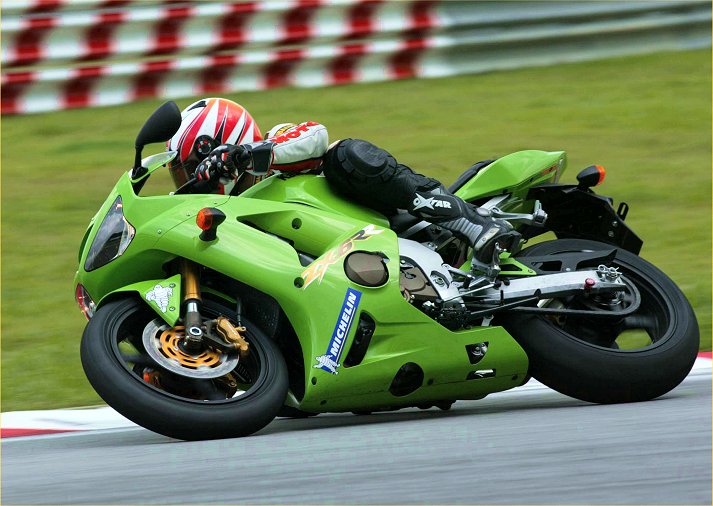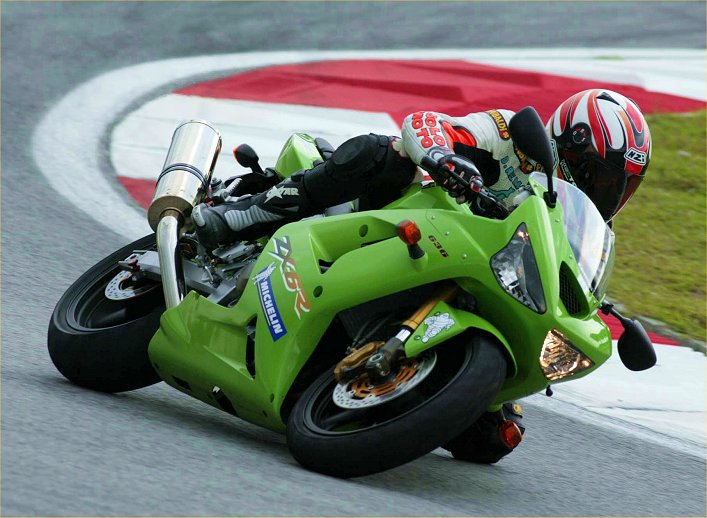
Courtesy of our friends at Solo Moto, the following is a brief report from the world launch of the 2003 ZX-6R (displacing 636cc) and ZX-6RR (displacing 598cc) at Sepang, Malaysia. Please blame any deficiencies in this report on the editing skills of MD. Keep in mind, also, that MD will provide its own ride review of these new machines when Kawasaki conducts its U.S. intro next month. Here is Solo Moto’s report
Highlights
The new ZX-6R and RR will arrive in Spain in the middle of February with a sticker price around 10,000 euros.
It will be sold in three colors, blue, black and green, with the latter being the only one offered without a metallic finish.
Braking power is impressive and the suspension is exceptional.
Thanks to an extra 36cc in the motor of the ZX-6R, it beats the RR by more than three seconds per lap (at Sepang).
A New World
Kawasaki summoned us to Malaysia… There, in the impressive Sepang installation – one of the best circuits of the world (Ed. note – F1 races there, so it must be good) – Kawasaki exhibited its new design. The 100% humidity, and a continually cloudy sky to save us from the heat, provided an excellent scenario to test the motorcycle’s new qualities. The circuit is complicated and demanding, and it tested to the limit not only the motorcycle’s possibilities but the abilities of the journalists, as well.
The test was divided into two days; the first hour of the first day was chaotic. Motorcycles equipped with Michelin Pilot Sport tires (street tires, basically), which evidently was not the best option for the circumstances, were involved in three crashes before the Japanese realized that they needed more serious rubber. The bikes that were equipped with Bridgestone Battlax BT-010s were changed to BT-001s, and the those equipped with Pilot Sport were changed to Pilot Race. The tire change led the 636 to better its lap time by four seconds, and it is beyond words to express the difference in security and confidence it gave after the tire change.
The philosophy of these motorcycles has changed dramatically. The arm position is close to that of the Yamaha R6. The comfort of last year’s ZX-6R has been sacrificed in pursuit of more performance. The distance between seat and handlebars is smaller and the aerodynamic protection has diminished. The seat is smaller and the tank has been reshaped. The cowling space has been reduced and the dials have been shrunk to their minimal expression to reduce weight. All information is digital and a lap timer is included.

Total Difference
The truth is that all present were anxious to try the RR to feel the racing sensations [offered by this limited production machine — intended, essentially, for homologation of a supersport legal bike]. But nothing could be further from reality, since the strongest sensations came from the ZX-6R 636. It behaved much better against the clock, and the 636 was more fun and effective.
The limited slip system installed in the RR’s clutch to prevent the rear wheel from locking on aggressive downshifts worked well, thus helping with corner entry under heavy braking.
The effectiveness of the RR as a supersport racer, and the superior power of the 636, are evident and both are a 10 in terms of dynamic qualities. Either motor runs to 15,000 rpm with great ease. The brake system on these machines is the best we have tested to date on any motorcycle, because it is both powerful and controllable. The chassis is very rigid, despite the ram air intake passing through the frame, while the suspension performed extremely well.
For a definitive proof of their effectiveness, we will have to wait to see both versions perform on our Spanish roads now that they have lost their long distance qualities. The sacrifice is worth the penalty if the fight is to restore equality with the competitors. With Kawasaki’s resolve in MotoGP as well as SuperSport, we are going to have to get use to the lime green color. For the 2003 season, green will surely be the trend and it will be spelled with K.
The Oriental Echo
These are opinions of three Japanese reporters from three different magazines. They are very fast and have ample experience on street, as well as racing, motorcycles.
Toshihuro Wakayama:
“I liked the motorcycle and even though on the track I prefer the 636 over the RR because of the responsiveness of the motor, I believe that the RR has a great potential to be a winning motorcycle in SuperSport next season. -I believe the results will depend on the performance of its riders. The brakes are impressive and full of vigor like its motor.“
Hiroshi Maruyama:
“Of the two models, I liked the 636 better. The motor responds with energy. . . . and we must not forget the stupendous job the engineers have managed with respect to stability at high speed. I believe that if both motorcycles (the one for racing and the one for the public) respond in the same way, Racing drivers and buyers will be plenty satisfied.”
Keichiro Miyazaki:
“To design a street motorcycle that performs like the Kawasaki ZX-6 R/RR is a great accomplishment. The suspension and the brakes were the most surprising features, to say the least, and the motor once again shows that Kawasaki is a great institution when it comes to in-line four cylinders. Aesthetically, I find that they hit the mark. . . .“





